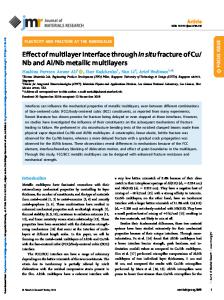Fracture and Fatigue Behavior in Nb 3 Al+ Nb Intermetallic Composites
- PDF / 4,442,713 Bytes
- 6 Pages / 420.48 x 639 pts Page_size
- 37 Downloads / 275 Views
FRACTURE AND FATIGUE BEHAVIOR IN Nb 3AI+ Nb INTERMETALLIC COMPOSITES
L. MURUGESH, K. T. VENKATESWARA RAO, L. C. DeJONGHE and R. 0. RITCHIE Department of Materials Science and Mineral Engineering, University of California, Berkeley, CA 94720.
ABSTRACT Model high-melting point Nb 3Al + Nb intermetallic composites have been fabricated in situ by vacuum hot pressing and reaction sintering elemental powders mixed in the ratio Nb + 7wt. % Al. In both cases, microstructures feature islands of ductile Nb solid solution (-20 vol. %) in a brittle Nb 3AI intermetallic matrix. Thermal treatment for 24 h at 1800°C results in a lamellar microstructure containing a uniform and fine distribution of filamentary Nb in a Nb 3AI matrix following the massive peritectic transformation. In this paper, the fatigue and fracture resistance of these two microstructures are examined and compared to pure Nb 3AI and Nb. Preliminary results suggest that the Nb phase can provide significant toughening to Nb 3AI via crack bridging, plastic stretching and interfacial debonding mechanisms. Measured plane-strain fracture toughness values for the as hot-pressed and fully-aged microstructures are -6-8 MPa,/m compared to -2 MPa%,fm for pure Nb 3AI. However, under cyclic loading, the composites tend to show a strong dependence on applied stress-intensity level; fatigue thresholds range between 2-3 MPa&/m. INTRODUCTION Niobium-based alloys have been the subject of renewed research interest since the mid1980's as the materials community continues to seek new high-performance materials for advanced high-temperature applications in aerospace propulsion systems [1]. One such alloy, Nb 3AI, possesses the properties that are required for an intermetallic compound to be useful as a high temperature structural material [2,3]. This alloy is preferred over Nb 2Al and Al 3Nb due to its higher melting temperature. However, like many intermetallics that exhibit high melting points and elastic moduli, Nb 3A! also has a low-symmetry, complex crystal structure (A-15). Although this structure is responsible for its high-temperature strength, it concurrently limits the number of slip systems, increases the slip vector, restricts cross slip and transfer of slip across grain boundaries [4,5], all factors which contribute to its limited ductility, toughness and tendency for brittle fracture at ambient temperatures; accordingly, Nb 3AI currently has limited structural use. One approach to improving the ductility and toughness of brittle intermetallics is to incorporate a ductile phase so as to impede crack advance by ductile-ligament bridging [6]. This may be accomplished either by artificially hybridizing the microstructure through powder-metallurgy techniques or by in situ precipitation reactions. In the case of the binary Nb-Al system, the peritectic reaction at 2060°C (Fig. 1), involving the precipitation of Nb 3Al from the liquid and hightemperature Nb solid solution (Nb,,), can be utilized for fabricating two-phase microstructures of Nb,, in a brittle Nb 3A! matrix: Li
Data Loading...











